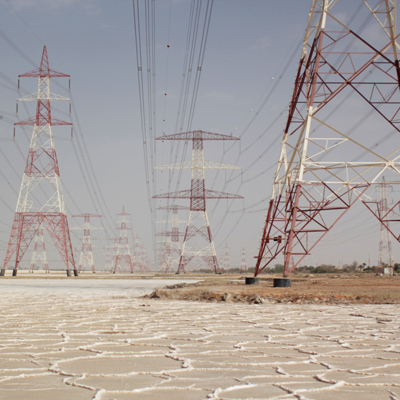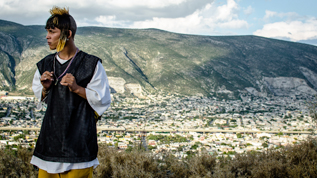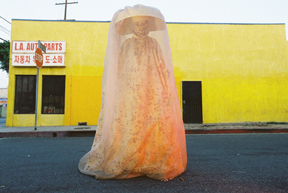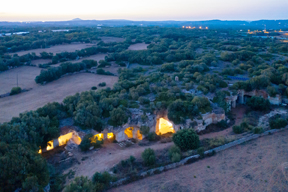Art: The World Around Summit 2021:
House of the Earth
By Christina Turczyn
arttimesjournal April 25, 2021
Dear darkening ground,
— you’ve endured so patiently the walls we’ve built,—
perhaps you’ll give the cities one more hour...
—Ranier Maria Rilke, as qtd. by El Futuro Imposible
Revolution
We can only see what we are prepared to understand. Cyra Levenson
"Revolution" is a word that can be applied to the World Around Summit 2021: Architecture's Now, Near, and Next, curated by Beatrice Galilee at the Guggenheim on January 30 of this year. The summit arose from a collaboration between twenty international thought leaders and the Solomon R. Guggenheim Museum, and centered upon contemporary issues of social justice, the violence of systemic racism, the imagination, collaboration, climate change, narrative, and socioeconomic equity. As museum director Richard Armstrong noted, the project is "an in-residence model [that might] provoke and answer some crucial questions about civic space and other architectural issues." The event began a yearlong residency at the Guggenheim for all of the participating artists.
 Wetland Wetland |
Since the World Around Summit was one of the best conferences I have ever attended, this review cannot be comparative, but seeks to foreground issues that emerged in the presentations. Those included both traditional architectures, with practices rooted in local knowledge, and a search for "architecture's next." Wai Wai, a multidisciplinary architecture, landscape, and urban design studio founded in Dubai, presented Wetland. According to the team, "sensitivity to cultural diversity created by having multiple locations in Tokyo and Dubai, as well as daily communication through the diverse backgrounds of individual team members, leads to a clear and simple architectural design with a deep understanding of the essence of things." Wetlands is a work in progress, whose progenitors hope to crystallize the salt flats, or sabkhas, of the area for a new building material. The cement blocks that they create can even continue to grow crystals, such as those in the medieval city of Siwa.
Sumayya Vally, arguably one of the world's most distinguished architects, was the youngest professional to receive the Serpentine Pavilion commission. World Around conference themes addressed, also, Sumayya Vally's discussion of the mines in her native South Africa—she spoke of fragmentation and hidden layers, even death. I was reminded of Nadine Gordimer's harrowing story, Once Upon a Time, which beyond its innocuous title revealed the self-devouring system of apartheid.
Equally compelling was Dear Darkening Ground, the climate animation after Rilke, created by El Futuro Imposible, a group of artists based in Argentina who work in the additional media of film, animation, and design. Far from promoting an apocalyptic view, one of the members of the collective mentioned that our current economic and global crises are “a crisis of the imagination,” as at this time, “envisioning a world without garbage, violence, and poverty seems almost impossible." And the imagination, viewed perhaps as a space in the present in which we dream the present through the Mobius strip of the future, was yet another central concept of the World Around Summit. Fernando Frias, producer of the film I’m No Longer Here, is a Mexican filmmaker who studied at Columbia University on a Fulbright. (His film is shortlisted to represent Mexico at the Oscars in 2021). Frias foregrounded the countercultural movement around Cumbia, as the dance and music unfolded against a threat of violent environments. Speculative architect and filmmaker Liam Young, a presenter, noted that "in many ways, the future is a verb."
He believes that his work challenges viewers to consider some of the technological changes that will be necessary when we confront climate change head-on. Young works in film and fiction to devise a future city in which harrowing conditions, such as a filtering panel acting as sky, force viewers to consider currently destructive urban practices. Originally from Australia, Young mentioned that the goal of Planet City is "not to present a proposal, but a provocation—to get us to see actually how extreme and absurd the way we make current cities is."
The emphasis on collaboration was a common thread: Liam Young saw his project, which invited the perspectives, of scientists, writers, and others, as "a massive, atomized brain distributed across the planet." Sumayya Vally noted that she still acknowledged the agency of authorship in architecture, yet she felt that her work "could only be deepened and enriched by listening to others."
Walls
Every wall that you make is also a wall that you try to dismantle at
the same time. —Beatrice Galilee
If you were waiting for mere structures, this was not the conference for you. In the past year or so, I often thought about what the ideological precursor to the border wall in the United States meant for an internal construction of the Other, even before any notion of that Wall was realized. The World Around Summit dismantled any preconceptions that attendees may have held about architecture, internally or externally. In his presentation on designing the National Assembly of Benin, Francis Kéré spoke so powerfully about his inclusive vision. Diverging from what he termed ”imported“ and overly replicated forms of postcolonial architecture, Kéré hoped that architecture in Benin and beyond would incorporate what he believed was missing, "a reflection of the West African way of governance." For Kéré, that reflection is democratic, dialogic, and communal. The design of the National Assembly embodies and expresses what Kéré terms an organic architecture. Situated in a botanical garden, the National Assembly was inspired by the practice of sitting under a tree. Traditionally, Kéré explained, the tree was a place where people came to speak and gather. The tree could become, by turns, a town hall, a school, a temporary COVID hospital, or a court.
By contrast, in her groundbreaking work, Sumayya Vally of Counterspace spoke to the ways in which architecture can separate, marginalize—and her architecture is, as well, a testimony to taking walls down. Her design of the Serpentine Pavilion embraces architectural components that can be dismantled and moved, so as to reach diverse London communities. “There is so much of our context that is ahead of architecture...that has been excluded," she affirmed. In the course of discussing her upcoming film, Umhlaba, Vally defined the Zulu title as more than "world," but also "land, soil, and ground." The film was inspired by many poets, including Gloria Anzaldua, as Vally's work was informed by performance, choreography, and activism. She is, in her work, "searching for our relationship to the land…also to how territories are entangled and bound."
 Fernando Frías, Ya No Estoy Aqui Fernando Frías, Ya No Estoy AquiStill from Ya No Estoy Aqui (2020) Directed by Fernando Frías |
During the conference, I was reminded of how land and space are apportioned for discriminatory practice. In the course of his presentation, Frias, mentioned the economically devastated areas of Monterrey as hidden from view, even through the presence of tunnels. He spoke about how the young dancers refused to accept identities prepared for them by cultures at large. As individuals who might be marginalized by lack of opportunity or a sense of their futures, they defied the status quo through this brief but powerful movement. Directors of the Cave Bureau, a Nairobi-based bureau of architects and researchers, brought to light the history of the Shimoni Caves in Kenya. In distinct curations of the Anthropocene Museum, they searched for ways in which communities could actively work against leveling environmental practices. Their members believe that "Africans need to redefine the museum," as museums are ancient structures that mirror colonial practice. Particularly fascinating was the Bureau's preservation of interviews—perspectives of individuals who know their environments best were inscribed onto leather mats, cast into bronze, and then distributed to multiple locations.
Imagination
I'm really looking to fold the pavilion outside into the city, and then
to fold the city into the pavilion—Sumayya Vally
In the course of presenting films, as well as groundbreaking presentations, interdisciplinary artists of El Futuro Imposible also believed, as I do, that emotions and the imagination need to be lived, heeded—as without feelings, we cannot have life. I think that this is especially critical now, since people are connected, albeit outlined, in Zoom settings. I can't help but wonder what the format does to re-affirm hierarchy—seeing becomes vision within a frame. Without closeness, we are so divided. In contrast, artists of El Futuro Imposible exploded frames when they mentioned that: "The desire to change the world is not only generated with information. That desire is very linked to emotions such as hope and optimism. That is why we want to tell a story." If hope were a word too mired in falsely political, uncanny radiance, the work of this group offered an empowering model through creating animated pieces that juxtaposed animation and real footage. Work of this kind cannot be presented in three dimensions, I feel, since viewers bring their own selves and identities to the borders, silences, and spaces of the text. Theirs is an ongoing attempt to create a collective, worldwide documentary. Anyone can contribute to this collective form of the imagination.
Narrative
We are in a current moment where fiction is perhaps the best way for us
to come to terms with a world that reality struggles to grasp.
—Liam Young
 Planet City (2020), Directed by Liam Young. Pictured here is the High Altitude Bot Herder. |
In his film Planet City, speculative architect Liam Young asked viewers to consider the role of narrative in re-defining an architecture of the future. Young posited a world in which ten billion people lived in one metropolis, Planet City, while the rest of the world as we know it was left to regenerate and return to a more natural state. The way in which cities currently fail, Young believes, almost forces architects and others to consider future cities that will change in the face of climate threats. This in turn brings us back to the present, as we need to confront those issues, now.
In the face of the pandemic, ours is a world that reality cannot contain. Critical narrative changes structures as much as structures alter narratives. Without them, art does not breathe. I have always thought of architecture as a form for cries heard and unheard—of both witness and history. The transformative work of BlackSpace, an urbanist collective based in NYC, is evident in the Manifesto, submitted as their project. I was extremely drawn to the work of this collective, whose members brought together planners, architects, artists, and designers as people who are passionate about the work of public systems and urban infrastructures. BlackSpace imagines radical means of urban expression that put black lives at their center, while drawing upon local knowledge. Knowledge is to be shared, collaborative, open, alive. Through the Manifesto, we are encouraged to "create circles, not lines," to "center lived experience," and to "move at the speed of trust." This is excellent advice, as the members of the collective also ask us to consider "critical connections over critical mass."
Opening Up
We are creating buildings that allow for dream—that push outside of
the increasingly monolithic ideas of what architecture and democracy
should be— to look like today. Francis Kéré
 Ensemble Studio Ca'n Terra Photo: Iwan Baan |
When in my thoughts I returned to Ca'n Terra (House of the Earth) in Menorca, I considered ways in which the Ensamble Studio architects described stone as a latent force, the pattern already there, meant to be unearthed and taken care of. At the same time, this abandoned quarry revealed endless planes of refracted light. I thought of Cave Bureau, whose artists moved the idea of a museum away from objectification, colonial discourse. Self-representation emerged over and over as a central theme of the conference—yet the discussion moved so far beyond representation only. The proposed architecture does not enclose, but continually opens up.
In another time and place, I return again and again to Blackspace. The collective promotes an architecture of recollection, preservation—as it also creates an architecture for the now. I think of narratives and silence. When Fernando Frias spoke about the tension in Monterrey between drug wars and the military, the livestream was suspended, ostensibly for policy violations. "I do not want to glorify violence," Frias said. Although the Guggenheim immediately tried to address this, the audience was shaken. I could not help but wonder how this happened, and why. I felt compelled to mention that silence is a form of propaganda.
All of these artists worked against erasure. What kind of architecture will honor the spaces of those killed? What kind of architecture will honor their voices? What kind of architecture will not only comfort but confront?
Viewers can watch the World Summit 2021 on YouTube in Sessions One, Two,
And Three.
